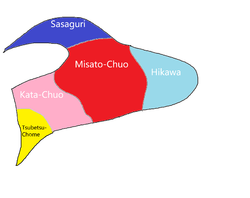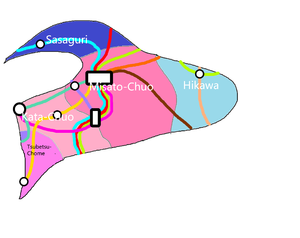Difference between revisions of "Misato City"
Views
Actions
Namespaces
Variants
Tools
Micahmouse (talk | contribs) m (→Districts) |
Micahmouse (talk | contribs) m (→Transportation) |
||
| Line 129: | Line 129: | ||
|- | |- | ||
|古殿 | |古殿 | ||
|[[Furudono Station|Furudono]] | |[[Furudono Station|Furudono]] (Former) | ||
|FRD | |FRD | ||
|[[Iizuna Line]] | |[[Iizuna Line]] | ||
|[[Aotetsu]] | |||
|[[ | |||
|- | |- | ||
|空 | |空 | ||
| Line 183: | Line 181: | ||
|[[Ikeda Station|Ikeda]] | |[[Ikeda Station|Ikeda]] | ||
|IKD | |IKD | ||
| | |[[Misato City Tram]] | ||
[[Misato City Tram]] | |||
|[[Lamtsu Metro]] | |[[Lamtsu Metro]] | ||
[[Lamtsu Rapid Transit]] | [[Lamtsu Rapid Transit]] | ||
Latest revision as of 12:59, 6 April 2023
| Number of lines | Yamate Line
Namboku Line Mihara Line Ome Line Sakuho Line Seiyo Main Line Lamtsu Main Line |
|---|---|
| Number of stations | Misato
Kata Shin-Kata Tsubetsu Hikawa Obaira |
| Depot(s) | Kata Depot |
|---|
Misato (美里区, Misato-Ku) is a special ward located in the Lamtsu Capital City, Sorano. It is the 2nd smallest of the special wards in Lamtsu, and is known as Misato City in English.
The current borders of Misato City were drawn from the borders of the old Misato walls, and the other wards were expanded to cover the extra distance. However, Misato City absorbed Kata District from Lamtsu in 2012. Due to this, Misato is significantly more developed towards the geographical north instead of south due to the Lamtsu urbanisation patterns. (In no small part due to the railways.) Misato is the cultural and economic centre of Lamtsu, although Lamtsu City is the official capital and seat of government.
Misato City is the economic centre of the entire Sorano Empire, housing the headquarters of 43 of the 100 largest companies in Sorano, which constitute close to 10% of it's entire GDP. It is estimated that this single ward produces what is equivalent to 1/6 of the entire national GDP. With a day population of around 700,000 and a night population of just 1,200, Misato City has by far the greatest day/night population difference in the entire country. The SSE150 is calculated by the Misato Bank.
Misato City is also the cultural centre of Lamtsu, being the original capital of the Misato Kingdom, which has both significant historical and religious value in the region.
History
Misato Kingdom Era
Misato was once the capital of the Misato Kingdom, from 200AD (religious) or 800AD (recorded history) to 1362AD, when it fell to the Fuka Clan and the Sorano Nation. At the time, the Kingdom had an isolationist policy, refusing to trade or engage with outsiders. There are very few non-religious records of the kingdom's history, and many of them have clear exaggerations in their content. This was likely due to the history being passed down by word-of-mouth, and therefore the records would have gotten twisted and distorted as time passed.
The Capital was briefly moved to Hakone in 981AD, when the possibly mythical Light Emperor (who claimed to be descended from the first Apostle) engaged in a policy of expansionism, pushing the borders to the west all the way to Shirakawa, a neutral City-State at the time. However, with his unnatural death in 1002AD, from what was most likely a heart attack, the superstitious, pious and conservative subsequent ruler withdrew the border all the way back to Tai Hing Island, after much prodding by the 17th Apostle, after which the Capital was once again moved back to Misato.
The Misato Kingdom was forced to break the policy of Isolationism in 1323, when the Fuka Clan and the Sorano Nation began to start a great number of raids on the borders of the Misato Kingdom. With inferior numbers and technology, the Misato Kingdom sent a plea to the Mishato City for assistance. However, the 21st Apostle knew that there would be no way for the tiny Misato Kingdom, even with the magical assistance of the Galdr, to defeat the sheer numbers of both the Sorano Nation and the Misato Kingdom.
(The following section is recorded in only the religious documents of the Mishato City, and the veracity of the following section is under heavy dispute by historians.)
The Misato Kingdom was completely conquered, with the little left of the army left retreating into the Mishato City. Due to the use of Galdr by the apostle, this relatively small force was able to hold off the far larger detachments sent by the Fuka Clan. The detachment retreated, and reported that they were fighting "men who seemed to never die", which led to them leaving the city alone.
Fuka Era
The border was drawn at Tai Hing Island, with the Fuka Clan getting Tai Hing Island and the land East of the Misato City Walls, and everything south to the Sorano Nation, excluding the forest and coast to the north-west of the Misato City Walls, which was granted to the Sorano Nation as an enclave, for them to bury their dead due to the many battles fought in the area. The enclave was granted city-state status, and this high degree of autonomy has been a roadblock to development in the North Misato area ever since then, with the Mihara Line skirting the area. The Sora Special Administrative Area is still under the direct control of the Sorano Monarchy, and as such the City Government is unable to do anything about it.
Misato was at the centre of the Sora-Fuka wars, and shortly after the truce of 1323, the two nations once again went to war, with the 1st Sora-Fuka War breaking out in 1342, when the Fuka Clan successfully conquered all the territory of the Lamtsu Peninsula. Misato City saw heavy damage to the city walls, and when the Fukan Border expanded all the way to the entire peninsula, it was decided that Misato City no longer had any need to repair the walls, and they were then slowly demolished to use for building material.
During the devastating collapse of the Fuka Shogunate in 1643, the Empire of Sorano conquered all of the Lamtsu Capital City, and got all the way to Ome and the Seiyo river, thus handing Misato to the Empire of Sorano.
Early Sorano Era
The Early days of Misato in the Sorano Empire were mostly uneventful, with the city losing a significant amount of population to towns like Hakone and Lamtsu, as it had been reduced from a Capital to a City. However, there were a few events of major historical significance in this time.
- 1672: Emperor Hiro is assassinated while on a trip to Misato, by a group of dissidents who wished to free the Misato Kingdom from Sorano rule. This led to the execution of 1 of every 10 male citizens in Misato, chosen by drawing lots.
- 1688: The Great Fire of Misato breaks out, causing close to 20,000 deaths and leaving 800,000 homeless. The following rebuilding with proper urban planning, replacing the Urban Sprawl, led to Misato having extremely straight roads and the population ballooning to 1.8 million by 1776.
Capital Era
Misato was the regional capital of the Lamtsu Peninsula from 1667 to 1941, and was the capital again from 1945 to 1952, before it was decided to follow the system the Japanese had implemented from 1942 to 1945, and reduced the city for the last time to a Special Ward of the Lamtsu Capital City. As the Capital, Misato City had helped to decentralise the Sorano Administration of the region, and also helped establish the modern system of Sorano Government.
Misato's administration differed significantly from the Central Sorano Government, under the Sorano Emperor. Certain laws differed, and all services were provided by the regional government, with the central government having minimal influence in the region. This led to an increasing push in autonomy by the other constituents of the Empire of Sorano, with the Origin City, Rosaria City, and HMUR all breaking away from Sorano in 2020.
Japanese Occupation
(Adora write this bit)
Modern day
From 1952 to today, Misato City has been one of the special wards of the Lamtsu Capital City.
Geography
Misato lies in the top of the Lamtsu Plain, a relatively flat plain in the west of the Lamtsu Peninsula. The Sora Desert lies to the north-west of the ward. The northern area of the ward, bordering Mihara, houses Misato Station. The Lamtsu Ward lies to the south, and Otaki ward to the north-east. The ward is almost completely populated by offices, with a few commercial shopping malls and the rare high-class residential building.
Cityscape
Misato has no buildings under 5 floors (excluding railway stations) and is extremely densely built-up.
The majority of the districts in Misato are not inhabited, as they are occupied solely by office buildings or other commercial developments. Misato has the quietest nights of the entire city, as all of the commercial buildings close after 6pm. Therefore, working adults often travel to other wards such as Yamate or Yurakucho after work.
Districts
- Misato-Chuo
- Hikawa
- Sasaguri
- Kata
- Kata-Chuo
- Tsubetsu-chome
Kata
Kata District has 2 sub-districts and 6 neighbourhoods. Kata is mixed industry and offices, with the railroad being the main dividing line. West of Shin-Kata Station is mostly Industry, while East of Shin-Kata is only office.
- Chuo
- Kata-Chuo
- Oku
- Minami-Kata
- Sejia
- Tsubetsu
- Tsubetsu-Sanchome
- Tsubetsu Port
Transportation
Misato is served by a few railway stations and all the major railway companies in Lamtsu (excluding Chutetsu)
| Jap | Name | Code | Lines | Operator | District |
|---|---|---|---|---|---|
| 美里 | Misato | MST | Yamate Line | Harmony Rail Transit (Lamtsu) | Misato-Chuo |
| SMRT美里 | SMRT Misato | SMT | Kansai Main Line | Misato Railway Transport | |
| 古殿 | Furudono (Former) | FRD | Iizuna Line | Aotetsu | |
| 空 | Sora | SR | Ome Heritage Line | Ome Heritage Line | |
| 篠栗 | Sasaguri | SSG | Mihara Line | Harmony Rail Transit (Lamtsu) | Sasaguri |
| 氷川 | Hikawa | HKW | Yamate Line | Harmony Rail Transit (Lamtsu) | Hikawa |
| 西美里 | Higashi-Misato | HMS | Yurakucho Line | Lamtsu Metro | |
| 賀田 | Kata | KT | Yamate Line | Harmony Rail Transit (Lamtsu) | Kata-Chuo |
| 池田 | Ikeda | IKD | Misato City Tram | Lamtsu Metro | |
| 新賀田 | Shin-Kata | SKT | Kujukuri Line | Misato Railway Transport | Tsubetsu-Chome,
Kata |
| 尾久 | Oku | OK | Ome Line | Harmony Rail Transit (Lamtsu) | |
| 妹背牛 | Moseushi (Former) | MSS | Ome Line | Harmony Rail Transit (Lamtsu) | |
| 津別 | Tsubetsu | TBT | Kujukuri Line | Harmony Rail Transit (Lamtsu) |
Misato is served by all the Lamtsu Lines excluding the following:

